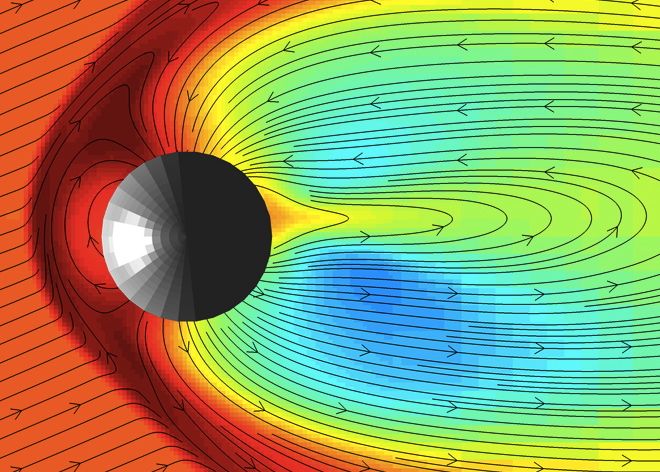In another of a series of firsts, NASA’s MESSENGER spacecraft has given us our first inkling of the intensity with which the solar wind sandblasts Mercury’s surface at its poles. New data analysis from a University of Michigan team, using an instrument aboard the spacecraft and published in a September 30, 2011, issue of Science, revealed this result.
The solar wind is a squall of hot plasma, or charged particles, continuously emanating from the sun, and Mercury is the innermost planet in our solar system. According to the Michigan team, the blistering solar wind kicks up sodium and oxygen particles, the primary components of Mercury’s wispy atmosphere, or exosphere. By interacting with the solar wind, the particles become charged in a mechanism similar to the one that creates the aurora borealis and aurora australis – the beautiful northern and southern lights – on Earth.
MESSENGER became the first-ever craft to orbit Mercury earlier in 2011. The University of Michigan team is using an instrument called the Fast Imaging Plasma Spectrometer (FIPS) aboard the Mercury MESSENGER spacecraft.

Earth and Mercury are the only two terrestrial planets in the solar system with magnetic fields, these scientists say, and as such, they can somewhat deflect the solar wind around them. Earth, which has a relatively strong magnetosphere, can shield itself from most of the solar wind. Mercury, which has a comparatively weak magnetosphere and is two-thirds closer to the sun, is a different story.
FIPS took the first global measurements of Mercury’s exosphere and magnetosphere. The measurements confirmed scientists’ theories about the composition and source of the particles in Mercury’s space environment.

FIPS project leader Thomas Zurbuchen said:
We had previously observed neutral sodium from ground observations, but up close we’ve discovered that charged sodium particles are concentrated near Mercury’s polar regions where they are likely liberated by solar wind ion sputtering, effectively knocking sodium atoms off Mercury’s surface.
Zurbuchen said:
Our results tell us … that Mercury’s weak magnetosphere provides very little protection of the planet from the solar wind.
Jim Raines, a FIPS operations engineer, said:
We’re trying to understand how the sun, the grand-daddy of all that is life, interacts with the planets. It is Earth’s magnetosphere that keeps our atmosphere from being stripped away. And that makes it vital to the existence of life on our planet.
The planet Mercury’s mean distance from the sun is 58 million kilometers, by the way, in contrast to 150 million kilometers for Earth’s distance.
Bottom line: It’s comfirmed: Solar wind sandblasts Mercury. An instrument called the Fast Imaging Plasma Spectrometer (FIPS) aboard NASA’s MESSENGER spacecraft has taken the first global measurements of Mercury’s exosphere and magnetosphere, confirming what scientists have suspected – that Mercury’s weak magnetic field offers little protection for the planet from the fierce solar wind from the nearby sun.
Via University of Michigan News Service
Extreme effects: Seven things you didn’t know about Mercury











